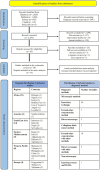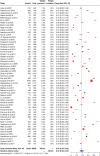Prevalence and correlates of soil-transmitted helminths in schoolchildren aged 5 to 18 years in low- and middle-income countries: a systematic review and meta-analysis
- PMID: 38577281
- PMCID: PMC10991833
- DOI: 10.3389/fpubh.2024.1283054
Prevalence and correlates of soil-transmitted helminths in schoolchildren aged 5 to 18 years in low- and middle-income countries: a systematic review and meta-analysis
Abstract
Background: According to the Global Burden of Disease (GBD) 2019 report, up to 1.5 million disability-adjusted life years (DALYs) are lost due to soil-transmitted helminths (STHs), and 5.9 million people are at risk of acquiring STHs. Regions with the highest prevalence of STH infections include Sub-Saharan Africa, China, South America, and Asia. While there are numerous fragmented studies on STH, comprehensive information on the prevalence and geographic distribution of different species, as well as their regional variations in the context of STHs is limited. The present systematic review and meta-analysis study attempts to provide a summary of the prevalence, geographical variation, and determinants of STHs among schoolchildren aged 5 to 18 years.
Methods: An extensive literature search was carried out using PubMed, Embase, Cinhal, and Psychinfo for studies published between 1999 and 2022 that reported the rate of STH infection in school-going children aged 5-18 years. A random effects model was employed in this meta-analysis due to expected heterogeneity. Subgroup analysis was carried out based on sex and STH species because of expected geographical variation.
Results: A total of 19,725 of the 49,630 children examined were infected with STH, yielding an overall pooled prevalence of 37.16% (95% CI: 29.74-44.89). The prevalence was highest in the Western Pacific region at 50.41% (95% CI: 33.74-67.04) followed by Europe at 39.74% (95% CI: 20.40-61.0) and Africa at 37.10% (95% CI: 26.84-47.95). Ascaris lumbricoides was found to be the most prevalent helminth with a prevalence of 24.07% (95% CI: 17.07-31.83).
Conclusion: The Western Pacific region is classified as a High-risk Zone (HRZ), while Southeast Asia, Africa, Europe, and the Eastern Mediterranean are classified as moderate-risk zones (MRZs). We found a 12% reduction in the pooled prevalence of STH infection from 1999 to 2012. Ascaris lumbricoides was the predominant species among schoolchildren. Mass Drug Administration (MDA) of Albendazole tablets and improved water, sanitation, and hygiene (WASH) practices are effective in controlling and preventing STH. Ensuring their implementation and access is crucial to addressing the problem.
Systematic review registration: https://www.crd.york.ac.uk/prospero/#loginpage, CRD42022333341.
Keywords: LMICs; NTDs; meta-analysis; school-going children; soil-transmitted helminths.
Copyright © 2024 Agrawal, Pattnaik, Kshatri, Kanungo, Mandal, Palo and Pati.
Conflict of interest statement
The authors declare that the research was conducted in the absence of any commercial or financial relationships that could be construed as a potential conflict of interest.
Figures
Similar articles
-
Prevalence and distribution of soil-transmitted helminth infections in Nigerian children: a systematic review and meta-analysis.Infect Dis Poverty. 2018 Jul 9;7(1):69. doi: 10.1186/s40249-018-0451-2. Infect Dis Poverty. 2018. PMID: 29983115 Free PMC article.
-
Interventions to improve disposal of child faeces for preventing diarrhoea and soil-transmitted helminth infection.Cochrane Database Syst Rev. 2019 Sep 24;9(9):CD011055. doi: 10.1002/14651858.CD011055.pub2. Cochrane Database Syst Rev. 2019. PMID: 31549742 Free PMC article.
-
National mapping of soil-transmitted helminth and schistosome infections in Ethiopia.Parasit Vectors. 2020 Sep 1;13(1):437. doi: 10.1186/s13071-020-04317-6. Parasit Vectors. 2020. PMID: 32873333 Free PMC article.
-
Spatiotemporal distribution and population at risk of soil-transmitted helminth infections following an eight-year school-based deworming programme in Burundi, 2007-2014.Parasit Vectors. 2017 Nov 23;10(1):583. doi: 10.1186/s13071-017-2505-x. Parasit Vectors. 2017. PMID: 29169386 Free PMC article.
-
Soil-transmitted helminths in southern highland Rwanda: associated factors and effectiveness of school-based preventive chemotherapy.Trop Med Int Health. 2014 Jul;19(7):812-24. doi: 10.1111/tmi.12321. Epub 2014 Apr 21. Trop Med Int Health. 2014. PMID: 24750543
Cited by
-
Benzimidazole resistance-associated mutations improve the in silico dimerization of hookworm tubulin: An additional resistance mechanism.Vet World. 2024 Dec;17(12):2736-2746. doi: 10.14202/vetworld.2024.2736-2746. Epub 2024 Dec 6. Vet World. 2024. PMID: 39897360 Free PMC article.
-
Community-based prevalence, intensity and risk factors associated with soil-transmitted helminthiases and intestinal schistosomiasis in Apojola, Ogun state, southwest Nigeria.BMC Infect Dis. 2024 Nov 14;24(1):1302. doi: 10.1186/s12879-024-10175-9. BMC Infect Dis. 2024. PMID: 39543464 Free PMC article.
-
Efficacy of Albendazole and Mebendazole Against Soil Transmitted Infections among Pre-School and School Age Children: A Systematic Review and Meta-Analysis.J Epidemiol Glob Health. 2024 Sep;14(3):884-904. doi: 10.1007/s44197-024-00231-7. Epub 2024 May 2. J Epidemiol Glob Health. 2024. PMID: 38696109 Free PMC article.
-
Prevalence, associated risk factors and satellite imagery analysis in predicting soil-transmitted helminth infection in Nakhon Si Thammarat Province, Thailand.Sci Rep. 2025 Aug 4;15(1):28432. doi: 10.1038/s41598-025-14221-7. Sci Rep. 2025. PMID: 40760156 Free PMC article.
-
Navigating the Parasitic Landscape: Insights into Infection Patterns and Public Health Strategies in West Africa.Trop Med Infect Dis. 2025 May 6;10(5):125. doi: 10.3390/tropicalmed10050125. Trop Med Infect Dis. 2025. PMID: 40423355 Free PMC article. Review.
References
-
- World Health Organization (WHO) , Soil transmitted helminth infection fact sheet (2023). Available at: https://www.who.int/news-room/fact-sheets/detail/soil-transmitted-helmin... (Accessed February 6, 2023).
-
- Institute for Health Metrics and Evaluation (IHME) (2019) GBD 2019 cause and risk summary. Seattle, USA: IHME, University of Washington. (Accessed February 6, 2023).
Publication types
MeSH terms
Substances
LinkOut - more resources
Full Text Sources




